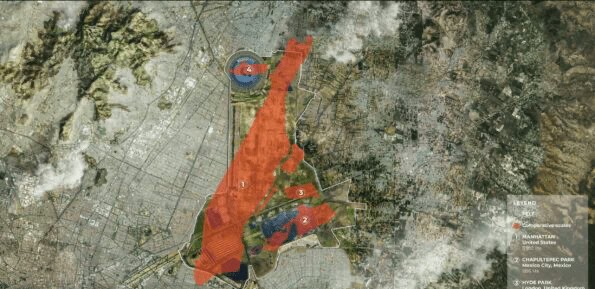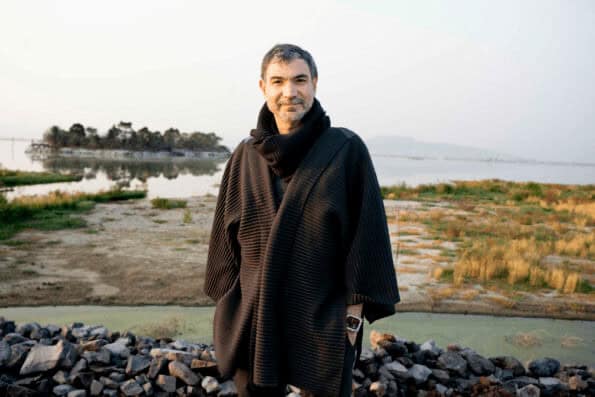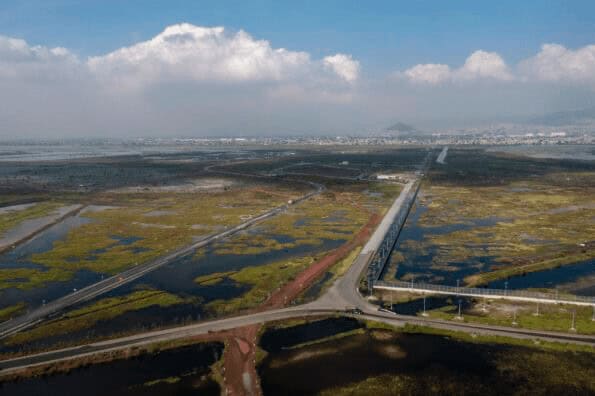Editor’s note: Paul Biasco first wrote about the Lake Texcoco Ecological Park for Ensia in early 2020. Here, the author revisits the park as it’s set to open to provide an update on the progress.
It’s unusually dry in this former lake bed in the Valley of Mexico. It hasn’t rained in weeks, and typically temperate Mexico City is in the midst of a heat wave. Residents are planning for a “day zero” situation, with water shortages impacting nearly every part of the city.
Iñaki Echeverria points toward the edges of the horizon where the plateau of the Valley of Mexico is surrounded by two volcanoes and mountains that create a barrier around the city based 7,350 feet (2,240 meters) above sea level.
“I remember as a child, snow almost up to the skirts [of the mountains] in normal times,” says Echeverria, an architect and landscape designer who has been tapped to lead the formation of the Lake Texcoco Ecological Park, an ecological restoration project in the valley that could end up being the largest urban park in the world. “[The lack of snow] is a very clear example of climate change, which is the context in which the project is being developed.”
Today birds fill one of the lakes, bobbing on top of the blueish-green water and peering out through the brush. Scientists hope more than 150 species will inhabit the area once the park is complete.

The wetlands are a sliver of an oasis that had been drained in one form or another over hundreds of years, starting with the founding of Tenochtitlan, the once-capital of the Aztec Empire, in the middle of a swampy lake bed. The city grew as a series of islands, and Spanish conquistadores later drained most of the lake system. As of 2015, Lake Texcoco had lost more than 95% of its surface.
That same year, the lake was set to be drained completely as the site was chosen for a US$13 billion airport. But when Andrés Manuel López Obrador became president in 2018, he canceled the airport despite the fact it was already one-third complete and appointed Echeverria to restore the ecosystem with the creation of the park spanning more than 14,000 hectares (34,500 acres).
“This project is a project of social and environmental justice in favor of all the people of the valley of Mexico, particularly the most vulnerable in the context of global climate change,” Echeverria says. “And it allows us to aspire to a broader project of restoration of the entire hydrological basin. The project of the lake alone cannot restore all of this, but it is a key and central piece for a broader process.”
Example for the world
Echeverria, who says he has been obsessed with the area for nearly three decades, isn’t seeking to restore it to the exact state it was before humans settled 700 years ago, but instead is implementing what he calls “soft infrastructure,” which lets nature act as builder with the right pieces in place.
“We try to understand what things can be, what things are, what things were, and by playing with that, we start working from there,” he says. “It’s a more open system where uncertainty and change in time are allowed.”

Instead of trying to construct the wetlands piece by piece, Echeverria’s revitalization experiment is repurposing parts left over from the airport construction, previous ecological ventures over the past 100 years and hydraulic projects that have sought to regulate water flowing into and out of the megacity for decades.
Echeverria sees the park as part of a broader awakening of sorts around the world where people are “going against the current,” saying, “a consciousness is beginning to emerge that clearly something is going wrong and that we all have to start looking for alternatives.”
Kevin Grecksch, a director in water science, policy and management at the School of Geography and the Environment at the University of Oxford, sees the wetland restoration project as a global example that could fill a gap in urban ecological planning.
“There’s a lot of writing of how adaptation should be done, but we don’t have enough literature of, ‘Is it actually successful?’” Grecksch says. “We want to see the projects that have been adapted to see if they are actually working. For big cities, seeing such a project like this can be a very valuable sign to go ahead with these projects. … It could send a strong signal to other big cities in the world.”
Specifics of the park
The park, located just northeast of Mexico City’s current international airport and less than 15 miles (24 kilometers) by car from the city’s historic center, is surrounded by roughly 4.5 million residents in some of the region’s more economically disadvantaged areas. The multifaceted design aims to achieve multiple goals.
A big one is to reintroduce the natural water and vegetation system of the valley, which the team behind the park hopes can spark other water restoration projects in the valley and metropolitan area.
“It allows us to aspire to a broader project of restoration of the entire hydrological basin of the valley,” Echeverria said. “The project of the lake alone cannot restore all of this, but it is a key and central piece for a broader process. Above all, and this is the ethos of the project, an expression of health.”

Jose Alfredo Ramirez, an architect and co-director of Groundlab, a climate change–focused design lab, says he views the project as the first step to a bigger solution.
“Cities like Mexico City require these types of projects and even more ambitious ones. If you know the story of Mexico City in terms of water management, it’s disastrous,” Ramirez says. “There needs to be a thinking away from controlling water and moving toward working with water. This project is one step in that direction, but it requires a lot more effort to make these things more ambitious.”
The second goal is to help regulate global temperatures by reducing the heat island that has formed because of draining bodies of water and paving over a vast region of the valley during the city’s expansion into a metropolis of more than 22 million people.
“Ironically, all this process caused the lake, which regulated the temperature and provided humidity to the environment, to [contribute to] the most terrible heat island in the whole valley,” Echeverria says.
The third is to provide green space and a connection to nature for residents surrounding the park.
For the park’s opening, there is only one main entrance, but entrances to connect the neighborhoods adjacent to the sprawling park are planned in the near future, according to Echeverria.
Ramirez, who previously lived in the Valle de Aragón near the park, says that connecting to the neighboring communities will be vital for the park’s future. This will ensure that whatever happens politically, neighbors and the park’s primary users will strongly support it.

“Before, there was nothing. No one was allowed the enter. It was just full of dust. …It was a no-man’s-land,” he says. “This project might have had a specific political spurt that allowed the project to happen, but the politics are always changing. You never know how much that support might shift in the future. You need something that makes the communities feel this project is part of their lives, something they can defend and maintain in the future. I think it needs to work more on how to incorporate the support and work of the communities that surround the area.”
The park includes a massive sports complex near its main entrance, bike and walking trails throughout, and a visitor center with a restaurant, museum and event hall.
“I think the key, with climate change, and especially climate change adaptation, is you need to have these local or regional solutions,” Grecksch says. “The problem is a worldwide one, but we also know it differs depending on the geography. … You create a wetland, so there’s water that should have a natural cooling effect. This is what we’re talking about when redesigning cities.”
The government expects the site to capture 1.5 million metric tons (1.7 million tons) of carbon emissions per year due to expanded green and wetland areas and to improve air quality by reducing exposure of bare soil, which causes dust storms and PM1 pollution in the region.
How It Happened
Pulling off an environmental project of this size required the costly cancellation of the airport and major political “risks,” given that the environmental results and permanent impact would not be seen for years.
Echeverria’s advice to planners around the world on achieving success on projects of similar scale boils down to four points.
First, according to Echeverria, the construction and planning among scientists, politicians, engineers and designers have been based more on a strategy than a concrete plan.
“The problem that we humans have is that we love recipes and recipes don’t exist,” he says. The plan would have been more complicated and would have had a greater chance of failure if the team wasn’t able to be flexible, he says. “I think it applies to all works of art. This is not a work of art, but it works in other areas as well.”
The second is that narrative matters. In some cases, creating the narrative for a project is more important than the specifics, especially when selling it to not only the public but also to decision-makers.
“The narrative is critical,” Echeverria says. “You have to have the capacity to transmit the possibility of other worlds, to invent a universe. … This capacity to create worlds to imagine and give an image to these worlds so that others can get excited and generate interest and become part of this — I think it’s one of the most important things you can do in a project, especially in this nature.”
The third point is to have an ambitious and clear leader — not always easy with projects of this scale.
“It needs someone who has vision and enthusiasm and the dedication to enthuse others, and the delivery to excite others,” Echeverria says. “More than 11,000 people have participated in this project. You need someone to create that narrative, to build it, to make others excited, so that they can make it happen. That’s the job of that leader.”
The fourth point is political leadership, which wasn’t lacking in this case. The president’s decision to cancel the airport ignited the restoration project.
Echeverria points to Chinese landscape architect and urbanist Kongjian Yu, whose book Letters to the Leaders of China: Kongjian Yu and the Future of the Chinese City sparked a national movement to take climate change solutions seriously at local planning levels.
“Something like [Lake Texcoco Ecological Park] — due to the investment it requires — requires an important political leadership,” he says. “That’s very clear. For example, Kongjian Yu in China, what he has been able to do is because he knew how to talk to politicians.”
According to Echeverria, the most difficult part of the yearslong process has been getting multiple agencies and types of experts to work together and agree on concepts involving scientists, engineers, designers and politicians.
At the end of the day, though, Echeverria says it has all been worth it.
“I hope it shocks people,” he says. “The size. The scope.”




